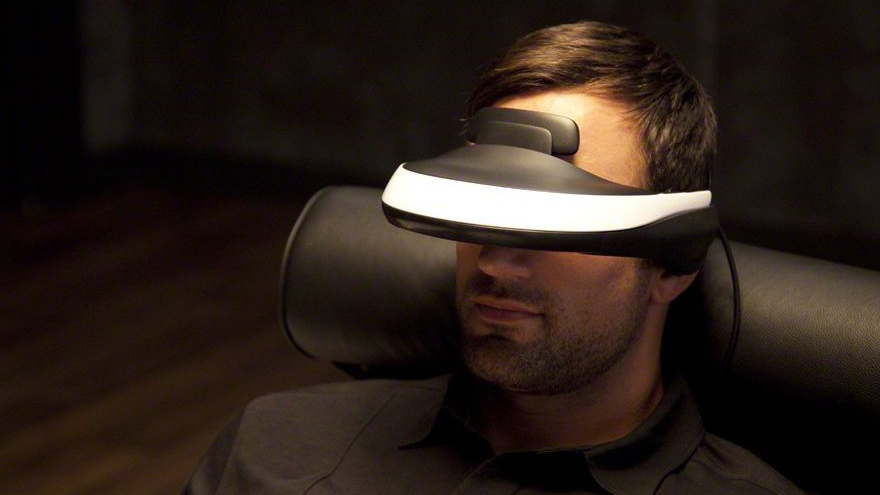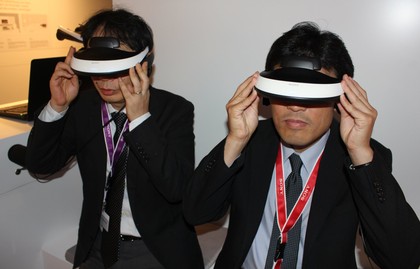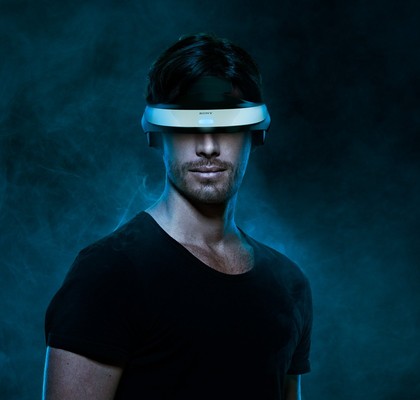
IFA is nothing if not a hotbed of crazy new tech, but probably the most arresting image to emerge from this year's show is the sight of bemused visitors struggling to clasp Sony's astonishing HMZ-T1 Personal 3D Viewer to their head.
Grimly futuristic, the white plastic visor with luminous blue power light looks more like a prop out of Fringe than a 3D display. No wonder folks fought to wear it - if only for a few minutes.
Thankfully, we got to spend rather more time with it. And although one of our writers felt the unit was a little bulky, I liked what I saw.
The HMZ-T1 is not the first time Sony's developed a heads up display. Back in 1997 the company touted the Glasstron, a viewer which looked very similar. It was standard def, of course, but utilised a motion tracker which changed the viewing perspective depending on how the wearer moved.
The concept was ultimately abandoned, as Sony's Masahiro Miura, explains "because it could not compensate for the amount of money invested in R&D."
It's a fate Sony's boffins say won't happen to the new 3D viewer. "The move to HD and 3D offers a lot more potential," says Miura.
It looks like Sony's HUD division is back in business.
Get daily insight, inspiration and deals in your inbox
Sign up for breaking news, reviews, opinion, top tech deals, and more.
The visor unwrapped
The HMZ-T1 Personal 3D Viewer features two OLED panels made by Sony's semiconductor division. According to Yoshinori Matsumoto, from Sony's Home Entertainment Business Group, the 0.7 inch (18mm diagonal) panels "have a resolution of 350,000 pixels and are closely related to the OLED electronic viewfinders found in the new Alpha 77 and NEX-77 cameras." Definition is comparable to 720p HD.
OLED production is notorious for high wastage and prompted Sony to put development on the back burner when it began to tighten its corporate belt, but Matsumoto-san says that while the technology is still fraught with production challenges, "yields are definitely getting better." In short, OLED is back in favour.

BEHIND THE SCREENS: Sony's 3D Viewer gurus Yoshinori Matsumoto (left) and Masahiro Miura (right)
As a 3D experience, the HMZ-T1 creates a unique sense of depth. Watching the latest 3D trailer for The Amazing Spider-Man (with all its POV building jumps) proves almost vertigo inducing.
OLED panels are much faster than their LCD equivalents and as a result there's no overlap between the left and right hand images. Significantly, this means no crosstalk double imaging. They're also capable of extremely high contrast. The panels incorporate an ingenious colour separation filter on top of a standard white organic layer, which creates vibrant colours.
The panels are also angled at 45 degrees within the headset. Matsumoto-san says this helps create the illusion of sitting in the stalls of a movie theatre. He says the virtual image equates to a 750-inch cinema screen.
The integrated sound system in the HMZ-T1 adds much to this illusion. It uses Sony's Virtualphones audio processing to create a convincing sense of surround.
A weight on the mind
Of course all the associated electronics make the HMZ-T1 rather heavy, and keeping the unit on your face is an ongoing challenge. To lock the 3D viewer in place, there's a plastic headstrap and forehead rest. Many of the demo models at IFA lacked the former, much to the consternation of those trying them out.
We found that while the headstrap supports the weight of the visor quite successfully, there is still a gravitational tug that tends to pull the device down your nose. Consequently, there's an instinctive urge to tip your head back. Quite whether you would want to do this the duration of an entire movie remains to be seen.
It's worth pointing out that the 3D viewer is not battery powered and must be tethered to a switching box for power and pictures. Any HDMI source can be connected.

NO WIRES? He may look cool but he's seeing nothing - the HMZ-T1 has to be linked to a switching unit for pictures and power
While the team from Sony couldn't confirm if using the HMZ-T1 would help those prone to 3D headaches, we think it could transform the entertainment options for those confined to bed rest. Personal 3D viewers on the NHS would certainly get our vote.
The gaming option
While Sony's team wouldn't officially commit to a UK price point, the impression given at IFA was that units will sell for around £800.
Of course the HMZ-T1 is not just about watching movies. The system has the potential to be a kick-ass gaming peripheral too.
There are a growing number of stereoscopic titles available from the PlayStation network and when hooked up to a PS3 for a quick gaming session, the HMZ-T1's paired OLED screens proved incredibly fast and responsive.
Suddenly 3D gaming began to verge on virtual reality. At this point we began to get very excited. Time to move beyond regular 3D?
The HMZ-T1 release date is expected to be this December.
Steve has been writing about AV and home cinema since the dawn of time, or more accurately, since the glory days of VHS and Betamax. He has strong opinions on the latest TV technology, Hi-Fi and Blu-ray/media players, and likes nothing better than to crank up his ludicrously powerful home theatre system to binge-watch TV shows.
